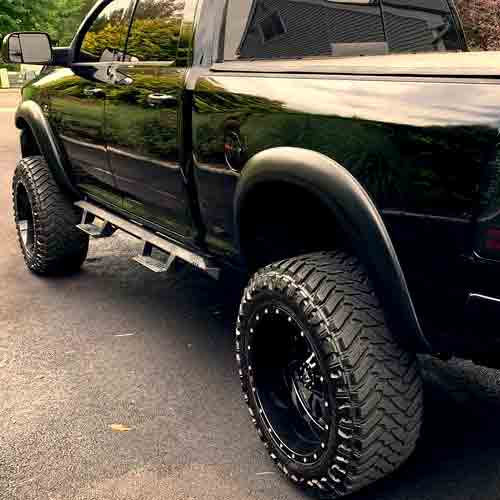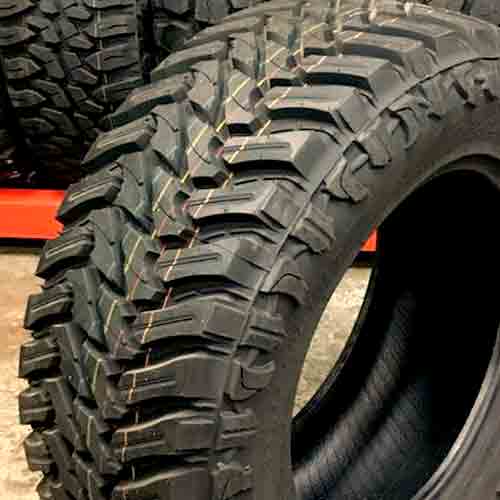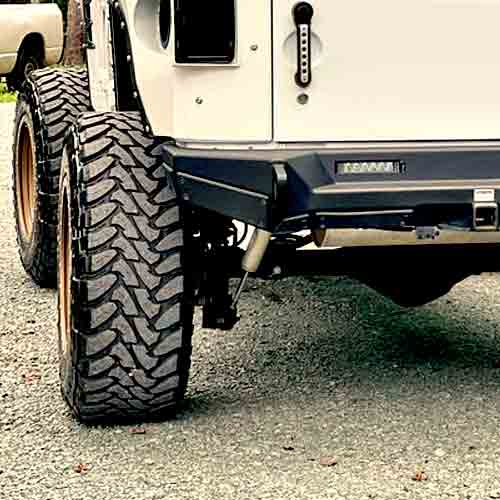Whether you’re driving a heavy truck or a full-sized SUV, both the Atturo Trail Blade MT and the Toyo MT have been engineered to supply drivers with the best possible performance, especially on rugged beaten paths. Let’s see which tire is made for you!

In my view as a tire engineer, the Atturo Trail Blade is a better performing tire when it comes to wet, winter and sandy grip performance. Moreover, relatively, the tire also does better with fuel. On the other side, the Toyo M/T features a more durable structure, and with it, presents greater mud traction, and grip on rocky terrains, and yes, you also get a better tread life with this tire as well.
Tire Sizing Guide
Toyo Open Country MT comes with following specs.
- Total sizes: 83.
- Rim sizes 15 to 26″.
- Speed ratings: Q.
- Tread depth range: 17 to 21/32″.
- Load range of C to F.
- Weight range: 50 to 110 lbs.
The Atturo Trail Blade MT comes with following.
- Total sizes: 17 only.
- Rim sizes: 16 to 22″.
- Speed ratings: R and Q.
- Load ratings: XL, D and E.
- Weight range: 40 to 80 lbs.
- Tread depth range: 17 to 20/32 inches.
Tread Styles and Features
Starting form the Atturo Trail Blade MT, the tire although looks a lot like its competitor, there are still a few things to consider.

Out of both tires, the Trail Blade features more aggressive sides, as you can clearly see (in the image).
It offers powerful sidewall lugs, with interlocking structure, providing a lot of bite and along with it, footprint, when you lower the air pressure.
And adding to that are joined-up staggered outer edges of shoulders.
These shoulder lugs are also very aggressive towards the middle (of the tread) as well, where they feature a very elongated pattern, yielding wide lateral (slanted) grooves with stone erectors in between.
And with the central lugs wrapping around them, you get the needed stability with them, too. (Though these central lugs with closed up designs are better in providing directional grip on smoother surfaces).
Moving on towards the Toyo Open Country M/T…

This tire feature less aggressive shoulder lugs in comparison, though with thicker design, they offer decent overall stability.
(They basically distribute the weight across themselves more evenly, when the tire corners, especially).
And on the outer edges, they features U shaped sidewall lugs.
In the middle, the tread has similar two ribs like seen on its competitor, though this tire makes a slightly more open structure which helps in self cleaning.
And although it would compromised on highway grip, the reinforced foundations underneath those blocks, supply adequate stability.
Dry Traction
On smooth roads and highways, there are two primary factors to consider: directional grip, which is generally easier for mud-terrain tires to achieve, and handling, a pretty challenging to achieve performance metric, as these tires have limited steering response.
Let’s discuss each factor in detail.
Directional Grip
Directional grip depends on the tread’s central footprint and is measured by the tire’s stopping efficacy.
Having said that, although it’s reasonable to expect similar braking distances for both tires across various sizes as they have equal footprints (almost), the Toyo MT still delivers better results due to its more compact lugs.
Basically this tire creates a more streamlined circumferential channels with its two longitudinal ribs, resulting in shorter stopping distances compared to the Atturo MT.
Sideways Grip and Stability
Handling, or lateral traction, depends on the tire’s sides, where the majority of its weight shifts during turns.
That’s why the Atturo M/T’s wider lateral shoulder voids lead to less consistent road contact compared to its counterpart, resulting in slightly slower handling times, even though the Toyo MT understeers due to its heavier weight.
Handling Feedback
Steering sensitivity relies on the tire’s communication with steering inputs.
And in both these areas, the Toyo Open Country MT lags behind due to its exceptionally heavier construction, weighing up to 110 lbs, making it one of the heaviest tires in the mud-terrain category.
This contributes to under steering and slower response times (because the tire creates greater inertia).
In comparison, the lighter Atturo Trail Blade MT performs better, although its softer tread compound doesn’t provide optimal support or responsiveness, as well. I mean its better here, compared to its counterpart, overall, it can be improved a little.
Wet Traction
Wet grip largely depends on a tire’s ability to clear water from its tread using sipes and grooves.
While both tires have ample tread voids for water evacuation, they lack efficient siping.
However, the Atturo Trail Blade MT still demonstrates better overall wet grip due to its spongier tread compound.
The Toyo M/T, on the other hand, has stiffer sipes.
FYI: Sipes work by absorbing water into their slits, so tread pliability enhances their effectiveness. If the tread is denser or harder, it would not allows sipes to create as much suction for the water particles coming underneath.
Fuel Consumption
As the tire rolls, the flexing of the tread blocks produce heat and frictional forces (between the tire and the road’s surface). And this causes a lot of energy loses form the fuel.
That’s why the Toyo MT, being heavier off the two tires, and having deeper tread voids, pushes its tread blocks to bend more, against the ground, leading to greater energy expenditure.
Whereas, with superior stability on Atturo Trail Blade MT, the tire comes out with lower rolling resistance values, and better fuel economy, as a result.
Tread Life
Just like fuel economy, how many miles a tire can cover in it’s life-time is also dependent on the rolling resistance, but that’s not all, as here tread depth and composition area also playing a key role.
That’s why the Toyo M/T is more appreciable in this section, with it’s more robust tread compound, less susceptible to burning off faster, relatively.
The Atturo Trial Blade MT on the other hand, wears faster with it’s spongier compound, and it’s tread depth isn’t helping to that either.
Suspension and Tires
When it comes to ride quality one of the main factors is how well a tire absorbs pavement vibrations. And here, the Atturo Trail Blade MT with it’s pliable tread composition, and larger tread depth cushions the imperfections of the road in a relatively better way.
The Toyo M/T on the other hand, although has similar voided structure, it’s greater weight limites on the overall maneuvering stability, especially on smooth tracks, comparatively.
Though the tire does great in the second part of overall comfort, which is tread noise.
Although with balder design, both tires allow air particles to independently flow in the tread, and strike with the walls around, generating unwanted sounds, at least you get better dampening of noise on Toyo Open Country M/T with its superior pitch sequencing technology.
It works by varying the geometry of the tread in a way, that different parts of it create different tones (as air particles hit them). And they try to cancel out each other.
Traction On Snow
Both tires are although not 3 peak mountain snowflake rated, that does not mean they would not be able to perform at all on snowy terrains.
In fact these mud tires are pretty great when it comes to aggressive snowy tracks, with deep fluffy snow.
Their thick and elongated tread blocks and voids yield amazing scooping and paddling abilities there, generating forward momentum with it (when they throw snow backwards).
Though still comparing both tires, I would have to go with Atturo Trail Blade MT, considering all factors, and testing these tires on multiple terrain types.
It’s tread is more thermal adaptive in comparison (meaning, its biters stay pliable with freezing temperatures), and it’s interlocking structure has more snow carrying abilities.
Off Road Traction
Off-road is a piece of cake for mud tires, though still, let’s consider all terrains, and see which tire comes on top still.
Muddy Trails
Mud is the toughest of all, that’s why we have dedicated MTs for this terrain type.
And here there are two things involved, mud scooping, and self cleaning of the tread. And considering both, I would have to rate the Toyo Open Country MT superior.
This is because, Toyo’s boy offers better shoulders, with thicker mud scoops in them, with a combination of sidewall lugs. All these yield the most needed paddling on the ground, while the thick mud is escaped out of its highly voided structure.
In case of Atturo, lugs are slightly more interlocking, and they create more hurdles for mud passing through, moreover, the tire also has shorter tread depth, so it can’t take on as much mud volume in comparison.
Rock Crawling
On rocky terrains, you need grip in all directions, and here the both tires with their massive shoulder lugs chew on rocks and offer ample traction.
So you can’t really put one over the other.
The Toyo MT offers more durability for this most puncturing terrain, and so you get a greater confidence riding on this tire.
Whereas the malleable lugs of Atturo Trail Blade sticks better, providing grip in a better way, it although lacks a little in lateral traction (by a very small margin), it’s directional grip makes up for it.
This basically makes it a better climber, and here its lighter weight is also helping with slopes.
Soft Sand
The less digging tire does better on sand, that’s why both weight and tread structure are major factors here.
Having said that, it makes sense why the Atturo Trail Blade MT, with lighter structure, and having sidewall lugs pasted on larger surface area, offers better traction values, relatively.
Whereas, in comparison, the Toyo MT stiffer sides isn’t that great.
Conclusion
It’s important not to skip any of the information provided earlier, as it’s based on extensive research. However, for the convenience of those in a rush, I’ll distill the essential points covered above.
The Toyo Open Country M/T demonstrates remarkable performance in the following aspects.
- Sand traction.
- Winter performance.
- Wet grip.
- Fuel economy.
On the other hand, the Atturo Trail Blade MT is better in following.
- Rock performance.
- Mud traction.
- Tread life.
- On-road noise.
- Dry grip.